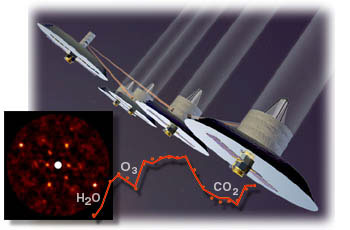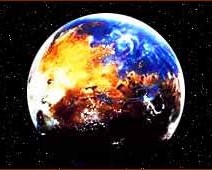 |
| What We Know About the Red Planet | ||||
| History | Water | Ice | Air | Canals |
| Seasons | Mountains | Rocks | SandDunes | Rift Valley |
| Moons | Dust Storms | Stats | Closest | Kid Pix |
| Lunar | Movies | Life Search | Wanted | Exploring Mars |
A major assignment for interplanetary spacecraft:
The Search for Life on Mars
A major assignment for the Viking 1 and Viking 2 interplanetary spacecraft was searching Mars for life processes based on a carbon biochemistry.
Searching outward for life in deep space
NASA artist concept
NASA Origins Program »So, the question of life on Mars, very important at the beginning of the 20th century, remains open at the end of the century. Mars remains the most likely candidate for life in the Solar System outside of Earth.
- Although the soil chemistry of Mars was found to be unusual and highly active, no conclusive evidence of biological activity was found.
- The result of a photosynthesis experiment indicated Martian soil was capable of breaking down carbon dioxide and making carbon compounds, as do green plants on Earth. A control sample, sterilized at high temperatures, showed almost no response.
- When the experiment was repeated in the presence of water, which should have enhanced a biological process on a dry planet, the response went to zero.
- Experiments showed strong chemical reactions to nutrients used.
- A test for organic compounds in the soil proved negative.
Further searching will be required to resolve conflicting results offered by the Vikings. Only a positive, unambiguous result will be meaningful.
The inability of Viking to detect life may mean there was no life on Mars, or it may simply mean the experiments were designed incorrectly.
A continuing search. During the recent five decades, America, Russia, Europe and Japan have sent numerous spacecraft to scout the Red Planet – including NASA's widely-known Pathfinder lander of 1997. Many others will follow. Here's more information on past and future Mars probes:
PAST AND FUTURE EXPLORATIONS OF MARS »
Origins. NASA's Origins Program looks for answers to a pair of enduring human questions:NASA puts it this way:
- Where do we come from?
- Are we alone?
Knowing "where we come from" means understanding how the great chain of events unleashed after the Big Bang culminated in us and in everything we observe today. It is the story of our cosmic roots, told in terms of all that precedes us: the origin and development of galaxies, stars, planets, and the chemical conditions necessary to support life.
Knowing our uniqueness – "whether we're alone" in the cosmos – depends on our search for life-sustaining planets and on our understanding of its glorious diversity here on Earth. Only by seeing the innumerable possibilities on our home planet can we be sure that we'll recognize life if and when we find it somewhere else.NASA's ORIGINS PROGRAM »
Learn more: Human Exploration of Mars:
There have been three stages of exploration so farFlybys:
Probes fly by Mars taking pictures Orbiters:
Spacecraft fly into orbit above MarsLanders and Rovers:
- Orbiters
- Mariner 8-9
- Viking 1-2
- Mars Observer
- Mars Climate Orbiter
- Mars Global Surveyor
- Mars Global Surveyor home
- 2001 Mars Odyssey
- 2001 Mars Odyssey home
- Mars Express
- Mars Express home
- Mars Reconnaissance Orbiter 2005
- Mars Reconnaissance Orbiter home
Landers and rovers drop to the surfaceSand dunes: Dust Storms: Air: Carbon Dioxide: Outflow Channels: Valley Networks: Rift Valley: Ice: Ice caps: Frost: Water: Artesian Water: Mars Weather: Mars Photo Galleries: Planet features: Canals: Rocks: Mountains: Dating and aging: Seasons:

